2019届二轮复习短文改错专题短文改错考点解读 课件(31张)
文档属性
| 名称 | 2019届二轮复习短文改错专题短文改错考点解读 课件(31张) |  | |
| 格式 | zip | ||
| 文件大小 | 100.1KB | ||
| 资源类型 | 教案 | ||
| 版本资源 | 通用版 | ||
| 科目 | 英语 | ||
| 更新时间 | 2019-03-11 17:02:44 | ||
图片预览


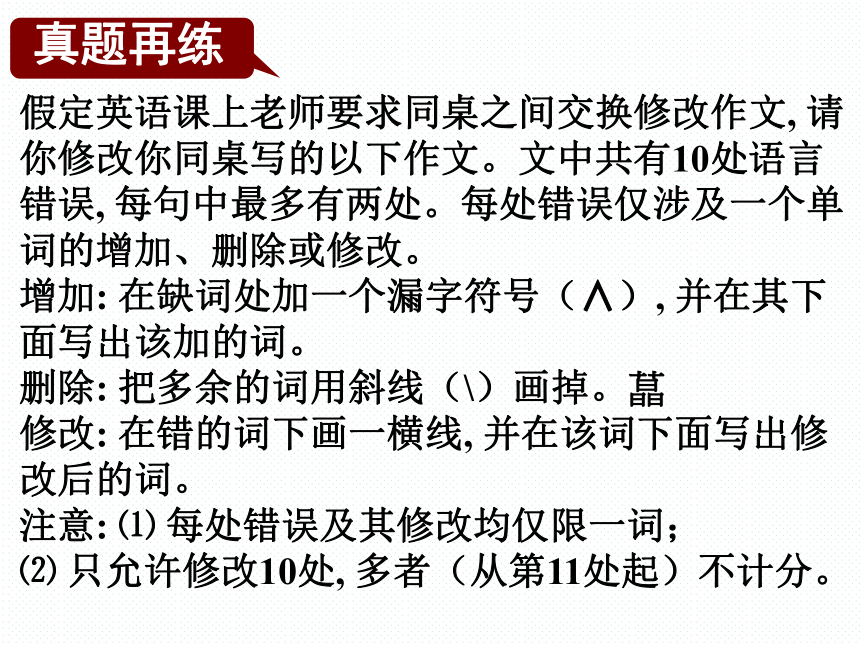

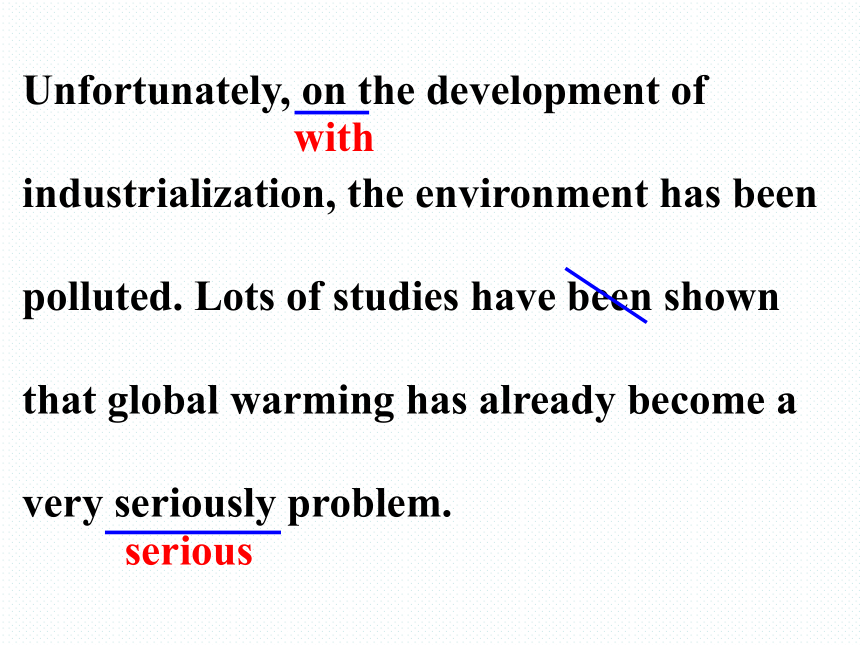
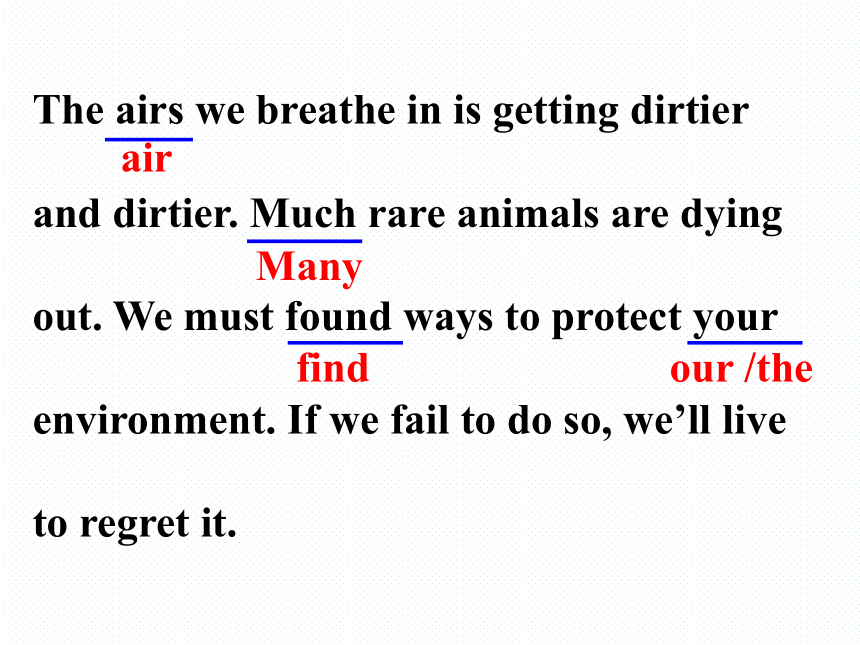
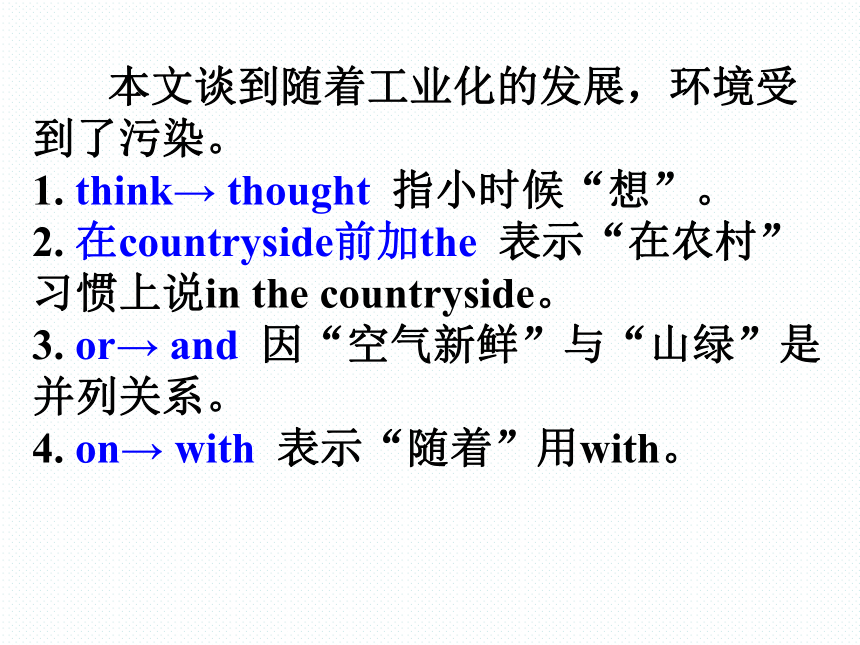
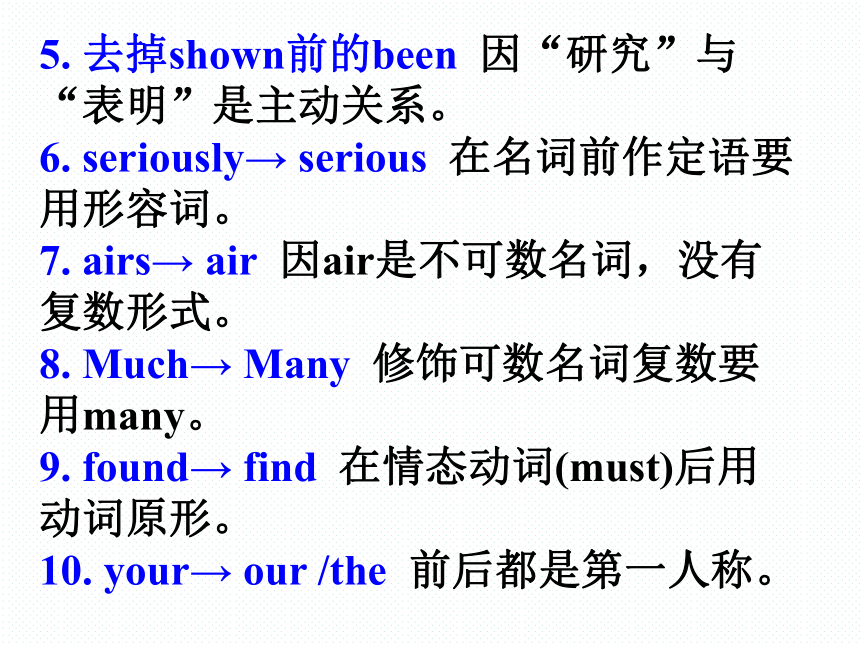
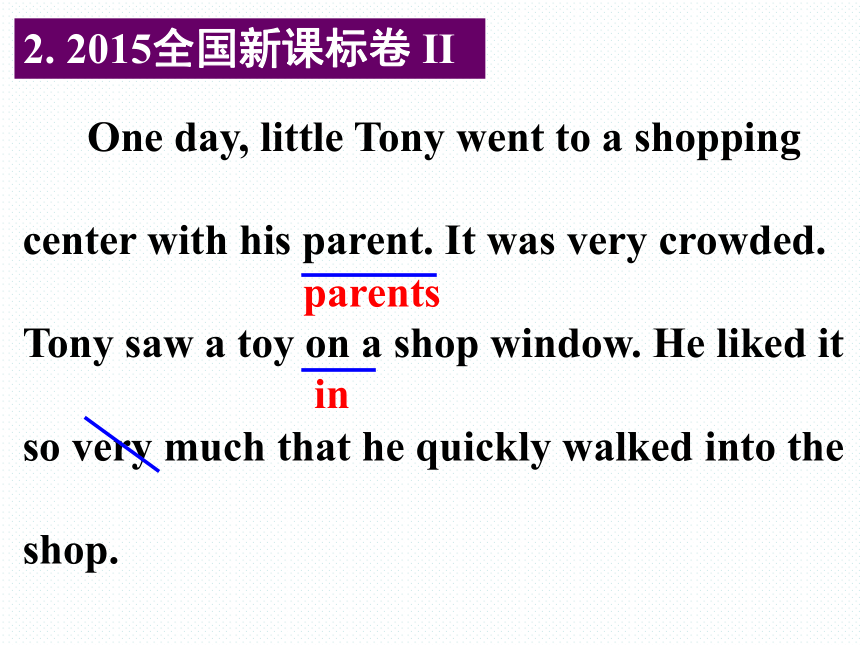



文档简介
课件31张PPT。2019届二轮复习短文改错专题短文改错考点解读真题再练命题特点备考指南假定英语课上老师要求同桌之间交换修改作文, 请你修改你同桌写的以下作文。文中共有10处语言错误, 每句中最多有两处。每处错误仅涉及一个单词的增加、删除或修改。
增加: 在缺词处加一个漏字符号(∧), 并在其下面写出该加的词。
删除: 把多余的词用斜线()画掉。?
修改: 在错的词下画一横线, 并在该词下面写出修改后的词。
注意: ⑴ 每处错误及其修改均仅限一词;
⑵ 只允许修改10处, 多者(从第11处起)不计分。1. 2015全国新课标卷I When I was a child, I hoped to live in the
city. I think I would be happy there. Now I
am living in a city, but I miss my home in
countryside. There the air is clean or the
mountains are green. Unfortunately, on the development of
industrialization, the environment has been
polluted. Lots of studies have been shown
that global warming has already become a
very seriously problem. The airs we breathe in is getting dirtier
and dirtier. Much rare animals are dying
out. We must found ways to protect your
environment. If we fail to do so, we’ll live
to regret it. 本文谈到随着工业化的发展,环境受到了污染。
1. think→ thought 指小时候“想”。
2. 在countryside前加the 表示“在农村”习惯上说in the countryside。
3. or→ and 因“空气新鲜”与“山绿”是并列关系。
4. on→ with 表示“随着”用with。5. 去掉shown前的been 因“研究”与“表明”是主动关系。
6. seriously→ serious 在名词前作定语要用形容词。
7. airs→ air 因air是不可数名词,没有复数形式。
8. Much→ Many 修饰可数名词复数要用many。
9. found→ find 在情态动词(must)后用动词原形。
10. your→ our /the 前后都是第一人称。 2. 2015全国新课标卷 II One day, little Tony went to a shopping
center with his parent. It was very crowded.
Tony saw a toy on a shop window. He liked it
so very much that he quickly walked into the
shop. After looks at the toy for some time, he
turned around and found where his parents
were missing. Tony was scared and begun
to cry. A woman saw him crying and telling
him to wait outside a shop. Five minutes later, Tony saw parents. Mom
said, “How nice to see you again! Dad and I
were terrible worried. ” Tony promised her
that this would never happen again. 本文叙述了Tony在购物中心与父母走散后,在热心人的帮助下找到父母的经历。
1. parent→ parents 由下文的his parents were missing可知用复数。
2. on→ in 据常识,玩具应在橱窗里面,故用in。
3. 去掉so后的very 这是so…that…结构,不用very。
4. looks→ looking 介词after后面接动名词,故用looking。
5. where→ that 或者去掉where宾语从句,从句的结构与意思完整,用that引导或省略that。6. begun→ began 因begin的过去式是began。
7. telling→ told 与前面的saw是并列谓语,用told。
8. a→ the 特指上文提到的那家商店,用the。
9. saw后面加his 指Tony的父母,故加his。
10. terrible→ terribly 修饰形容词(worried)用副词。3. 2014全国新课标卷I Nearly five years before, and with the help by
our father, my sister and I planted some cherry
tomatoes in our back garden. Since then—for all
these year—we had been allowing tomatoes to
self-seed where they please. As result, the plants are growing
somewhere. The fruits are small in
size, but juicy and taste. There are so
much that we often share them with
our neighbors. Although we allow tomato plants to grow
in the same place year after year, but we
have never had any disease or insect
attack problems. We are growing
wonderfully tomatoes at no cost!1. before→ ago 由后文可知是离现在有5年了,相对“现在”来说多久以前,要用ago。
2. by→ of 因with the help of sb.是固定短语,表示“在某人的帮助下”。
3. year→ years 由these可知要用复数。
4. had→ have 自那以后到现在,应是现在完成进行时。
5. As result→ As a result 因as a result是固定短语。6. somewhere→ everywhere 根据前句可知,是“到处”都生长着这种果树。
7. taste→ tasty 与形容词small, juicy并列,一起作表语,要用形容词。
8. much→ many 替代可数名词fruits,用many;由后面的them也可知是复数。
9. 去掉but或but→ yet 因but不与although连用,但yet可以。
10. wonderfully→ wonderful 在名词tomatoes前作定语,用形容词。My dream school starts at 8:30 a.m. and
ends at 3:30 p.m. They are three lessons in
the morning and two in the afternoon. We
didn’t need to do so many homework. 4. 2014全国新课标卷II Therefore, we have more time with after-
school activities. For example, we can do
reading for one and a half hour and play
sports for one hour every day. My dream school look like a big garden.
There are all kinds of the flowers and trees
around the classroom buildings. We can lie
on the grass for a rest, or sat by the lake
listening music. The teachers here are kind
and helpfully. They are not only our teachers
but also our friends. 1. They→ There 表示“有/存在”的there be句型。
2. didn’t→ don’t 据上下文,要用一般现在时。
3. many→ much 修饰不可数名词homework要用much,而many只能用于复数可数名词之前。
4. with→ for 此处for相当于to do或to take part in。
5. hour→ hours 英语中的可数名词,其数目凡是大于一就要用复数。6. look→ looks 一般现在时,主语是第三人称单数,谓语动词要加s,即一般现在时,三单加s。
7. 去掉flowers前的the 不是特指,不用the。意思是:教室周围有各种各样的花草。而不是有各种各样的“那些”花草。
8. sat→ sit 由or可知,sit与lie并列,都是在情态动词can后,用原形。
9. 在listening 后加to 因listen是不及物动词,表示“听”什么,要说listen to。
10. helpfully→ helpful 与形容词kind并列,一起在句中作表语,也用形容词helpful。1. 短文内容:与学生的学习或生活密切相关,好像就是学生的习作。
2. 短文长度:约100个词,不少于95词,也不多于110词。
3. 错误设置:每个句子最多有两处错误,即有的句子无错,有的句子只有一个错误,有的句子有两个错误。注意:一句不会出现三处错误。4. 错误类型:1处多1个词;1处少1个词;8处错一个词,即多词、少词和错词的比例是1:1:8。
⑴ 多一个词,要求考生删除的通常是:冠词、介词、连词、不定式符号、助动词。
⑵ 少一个词,要考考生添加的通常是:冠词、介词、连词、不定式符号、物主代词。⑶ 错一个词,要求考生改正的通常是:
① 名词:该用单数却用了复数,该用复数却用了单数,该用所有格的却用了通格。
② 动词:谓语动词的时态一致、主谓一致、过去式或过去分词的拼写错误;非谓语动词的三种形式(to do, doing, done)之间的混用。③ 代词:前后指代不一致。人称不一致、单复数不一致、性别不一致,以及主语与宾格的误用、形容词性物主代词与名词性物主代词的误用等。
④ 词类错用:该用形容词时却用了副词,该用副词时却用了形容词,以及其他词性之间的混用。⑤ 常用词的辨析:here与there, some与any, many与much, ago与before, beside与besides, ever与never, either与neither, very, much与very much, used to与be used to等。
另外,考过的还有do wrong与go wrong, cut off与cut down, think over与think of, somewhere与everywhere等。短文改错的考点与语法填空的考点是基本相同的。两种大题均以考查基本的语法知识为主。
我们不要淡化语法,因为没有语法就没有准确的英语;也不要深化语法,深化了就会步入语言学习的误区,使本来生动活泼的语言变得枯燥乏味,失去语言学习的乐趣。对此,命题人对语法的把握是适度的,只考最基本的语法,只考最常用词汇的用法,大多数在初中和小学就已学过,只要经常阅读,增强语法意识,都是些无师自通的内容。备考策略:在平时的写作练习中,要养成跟同桌或同学互改的习惯;老师批改后的作文要认真思考:错了哪些,为什么老师这样批改。Thank you !
增加: 在缺词处加一个漏字符号(∧), 并在其下面写出该加的词。
删除: 把多余的词用斜线()画掉。?
修改: 在错的词下画一横线, 并在该词下面写出修改后的词。
注意: ⑴ 每处错误及其修改均仅限一词;
⑵ 只允许修改10处, 多者(从第11处起)不计分。1. 2015全国新课标卷I When I was a child, I hoped to live in the
city. I think I would be happy there. Now I
am living in a city, but I miss my home in
countryside. There the air is clean or the
mountains are green. Unfortunately, on the development of
industrialization, the environment has been
polluted. Lots of studies have been shown
that global warming has already become a
very seriously problem. The airs we breathe in is getting dirtier
and dirtier. Much rare animals are dying
out. We must found ways to protect your
environment. If we fail to do so, we’ll live
to regret it. 本文谈到随着工业化的发展,环境受到了污染。
1. think→ thought 指小时候“想”。
2. 在countryside前加the 表示“在农村”习惯上说in the countryside。
3. or→ and 因“空气新鲜”与“山绿”是并列关系。
4. on→ with 表示“随着”用with。5. 去掉shown前的been 因“研究”与“表明”是主动关系。
6. seriously→ serious 在名词前作定语要用形容词。
7. airs→ air 因air是不可数名词,没有复数形式。
8. Much→ Many 修饰可数名词复数要用many。
9. found→ find 在情态动词(must)后用动词原形。
10. your→ our /the 前后都是第一人称。 2. 2015全国新课标卷 II One day, little Tony went to a shopping
center with his parent. It was very crowded.
Tony saw a toy on a shop window. He liked it
so very much that he quickly walked into the
shop. After looks at the toy for some time, he
turned around and found where his parents
were missing. Tony was scared and begun
to cry. A woman saw him crying and telling
him to wait outside a shop. Five minutes later, Tony saw parents. Mom
said, “How nice to see you again! Dad and I
were terrible worried. ” Tony promised her
that this would never happen again. 本文叙述了Tony在购物中心与父母走散后,在热心人的帮助下找到父母的经历。
1. parent→ parents 由下文的his parents were missing可知用复数。
2. on→ in 据常识,玩具应在橱窗里面,故用in。
3. 去掉so后的very 这是so…that…结构,不用very。
4. looks→ looking 介词after后面接动名词,故用looking。
5. where→ that 或者去掉where宾语从句,从句的结构与意思完整,用that引导或省略that。6. begun→ began 因begin的过去式是began。
7. telling→ told 与前面的saw是并列谓语,用told。
8. a→ the 特指上文提到的那家商店,用the。
9. saw后面加his 指Tony的父母,故加his。
10. terrible→ terribly 修饰形容词(worried)用副词。3. 2014全国新课标卷I Nearly five years before, and with the help by
our father, my sister and I planted some cherry
tomatoes in our back garden. Since then—for all
these year—we had been allowing tomatoes to
self-seed where they please. As result, the plants are growing
somewhere. The fruits are small in
size, but juicy and taste. There are so
much that we often share them with
our neighbors. Although we allow tomato plants to grow
in the same place year after year, but we
have never had any disease or insect
attack problems. We are growing
wonderfully tomatoes at no cost!1. before→ ago 由后文可知是离现在有5年了,相对“现在”来说多久以前,要用ago。
2. by→ of 因with the help of sb.是固定短语,表示“在某人的帮助下”。
3. year→ years 由these可知要用复数。
4. had→ have 自那以后到现在,应是现在完成进行时。
5. As result→ As a result 因as a result是固定短语。6. somewhere→ everywhere 根据前句可知,是“到处”都生长着这种果树。
7. taste→ tasty 与形容词small, juicy并列,一起作表语,要用形容词。
8. much→ many 替代可数名词fruits,用many;由后面的them也可知是复数。
9. 去掉but或but→ yet 因but不与although连用,但yet可以。
10. wonderfully→ wonderful 在名词tomatoes前作定语,用形容词。My dream school starts at 8:30 a.m. and
ends at 3:30 p.m. They are three lessons in
the morning and two in the afternoon. We
didn’t need to do so many homework. 4. 2014全国新课标卷II Therefore, we have more time with after-
school activities. For example, we can do
reading for one and a half hour and play
sports for one hour every day. My dream school look like a big garden.
There are all kinds of the flowers and trees
around the classroom buildings. We can lie
on the grass for a rest, or sat by the lake
listening music. The teachers here are kind
and helpfully. They are not only our teachers
but also our friends. 1. They→ There 表示“有/存在”的there be句型。
2. didn’t→ don’t 据上下文,要用一般现在时。
3. many→ much 修饰不可数名词homework要用much,而many只能用于复数可数名词之前。
4. with→ for 此处for相当于to do或to take part in。
5. hour→ hours 英语中的可数名词,其数目凡是大于一就要用复数。6. look→ looks 一般现在时,主语是第三人称单数,谓语动词要加s,即一般现在时,三单加s。
7. 去掉flowers前的the 不是特指,不用the。意思是:教室周围有各种各样的花草。而不是有各种各样的“那些”花草。
8. sat→ sit 由or可知,sit与lie并列,都是在情态动词can后,用原形。
9. 在listening 后加to 因listen是不及物动词,表示“听”什么,要说listen to。
10. helpfully→ helpful 与形容词kind并列,一起在句中作表语,也用形容词helpful。1. 短文内容:与学生的学习或生活密切相关,好像就是学生的习作。
2. 短文长度:约100个词,不少于95词,也不多于110词。
3. 错误设置:每个句子最多有两处错误,即有的句子无错,有的句子只有一个错误,有的句子有两个错误。注意:一句不会出现三处错误。4. 错误类型:1处多1个词;1处少1个词;8处错一个词,即多词、少词和错词的比例是1:1:8。
⑴ 多一个词,要求考生删除的通常是:冠词、介词、连词、不定式符号、助动词。
⑵ 少一个词,要考考生添加的通常是:冠词、介词、连词、不定式符号、物主代词。⑶ 错一个词,要求考生改正的通常是:
① 名词:该用单数却用了复数,该用复数却用了单数,该用所有格的却用了通格。
② 动词:谓语动词的时态一致、主谓一致、过去式或过去分词的拼写错误;非谓语动词的三种形式(to do, doing, done)之间的混用。③ 代词:前后指代不一致。人称不一致、单复数不一致、性别不一致,以及主语与宾格的误用、形容词性物主代词与名词性物主代词的误用等。
④ 词类错用:该用形容词时却用了副词,该用副词时却用了形容词,以及其他词性之间的混用。⑤ 常用词的辨析:here与there, some与any, many与much, ago与before, beside与besides, ever与never, either与neither, very, much与very much, used to与be used to等。
另外,考过的还有do wrong与go wrong, cut off与cut down, think over与think of, somewhere与everywhere等。短文改错的考点与语法填空的考点是基本相同的。两种大题均以考查基本的语法知识为主。
我们不要淡化语法,因为没有语法就没有准确的英语;也不要深化语法,深化了就会步入语言学习的误区,使本来生动活泼的语言变得枯燥乏味,失去语言学习的乐趣。对此,命题人对语法的把握是适度的,只考最基本的语法,只考最常用词汇的用法,大多数在初中和小学就已学过,只要经常阅读,增强语法意识,都是些无师自通的内容。备考策略:在平时的写作练习中,要养成跟同桌或同学互改的习惯;老师批改后的作文要认真思考:错了哪些,为什么老师这样批改。Thank you !
